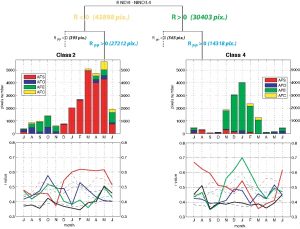l’article du mois – janvier 2014
 Timing and patterns of ENSO signal in Africa over the last 30 years: insights from Normalized Difference Vegetation Index data
Timing and patterns of ENSO signal in Africa over the last 30 years: insights from Normalized Difference Vegetation Index data
par N Philippon°, N Martiny°, P Camberlin°, T Hoffman* et V Gond¤
° CRC Biogéosciences, * Plant Conservation Unit – University of Cape Town, ¤ CIRAD
accepté dans Journal of Climate
A more complete picture of the timing and patterns of ENSO signal during the seasonal cycle for the whole of Africa over the three last decades is provided using the Normalized Difference Vegetation Index. Indeed, NDVI has a higher spatial resolution and is more frequently updated than in situ climate databases, and highlights the impact of ENSO on vegetation dynamics as a combined result of ENSO on rainfall, solar radiation and temperature.
The month by month NDVI-Nino3.4 correlation patterns evolve as follows. From July to September, negative correlations are observed over the Sahel, the Gulf of Guinea coast, and regions from the northern Democratic Republic of Congo to Ethiopia. However they are not uniform in space and are moderate (~0.3). Conversely, positive correlations are recorded over the winter rainfall region of South Africa. In October-November, negative correlations over Ethiopia, Sudan, Uganda strengthen while positive correlations emerge in the Horn of Africa and in the southeast coast of South Africa. By December with the settlement of the ITCZ south of the equator, positive correlations over the Horn of Africa spread southward and westward while negative correlations appear over Mozambique, Zimbabwe, South Africa. This pattern strengthens and a dipole at 18°S is well established in February-March with reduced (enhanced) greenness during ENSO years south (north) of 18°S. At the same time, at ~2°N negative correlations spread northward. Lastly from April to June, negative correlations south of 18°S spread to the north (to 10°S) and the east (to the south of Tanzania).
- extrait:
- lien_externe:
- kc_data:
- a:8:{i:0;s:0:"";s:4:"mode";s:0:"";s:3:"css";s:0:"";s:9:"max_width";s:0:"";s:7:"classes";s:0:"";s:9:"thumbnail";s:0:"";s:9:"collapsed";s:0:"";s:9:"optimized";s:0:"";}
- kc_raw_content:
 Timing and patterns of ENSO signal in Africa over the last 30 years: insights from Normalized Difference Vegetation Index data
Timing and patterns of ENSO signal in Africa over the last 30 years: insights from Normalized Difference Vegetation Index data
par N Philippon°, N Martiny°, P Camberlin°, T Hoffman* et V Gond¤° CRC Biogéosciences, * Plant Conservation Unit - University of Cape Town, ¤ CIRAD
accepté dans Journal of ClimateA more complete picture of the timing and patterns of ENSO signal during the seasonal cycle for the whole of Africa over the three last decades is provided using the Normalized Difference Vegetation Index. Indeed, NDVI has a higher spatial resolution and is more frequently updated than in situ climate databases, and highlights the impact of ENSO on vegetation dynamics as a combined result of ENSO on rainfall, solar radiation and temperature.
The month by month NDVI-Nino3.4 correlation patterns evolve as follows. From July to September, negative correlations are observed over the Sahel, the Gulf of Guinea coast, and regions from the northern Democratic Republic of Congo to Ethiopia. However they are not uniform in space and are moderate (~0.3). Conversely, positive correlations are recorded over the winter rainfall region of South Africa. In October-November, negative correlations over Ethiopia, Sudan, Uganda strengthen while positive correlations emerge in the Horn of Africa and in the southeast coast of South Africa. By December with the settlement of the ITCZ south of the equator, positive correlations over the Horn of Africa spread southward and westward while negative correlations appear over Mozambique, Zimbabwe, South Africa. This pattern strengthens and a dipole at 18°S is well established in February-March with reduced (enhanced) greenness during ENSO years south (north) of 18°S. At the same time, at ~2°N negative correlations spread northward. Lastly from April to June, negative correlations south of 18°S spread to the north (to 10°S) and the east (to the south of Tanzania).
